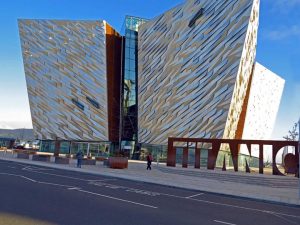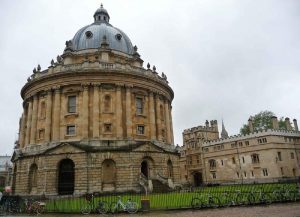by Erin Wiggins Shaver
My husband and I met in an American Irish pub, over the ubiquitous libation that is well known in the U.S. as the Irish Car Bomb. Five years later we finally experienced the real deal—on our honeymoon, no less—seeking the allure, merriment and mystique we’d always associated with the fabled Emerald Isles.
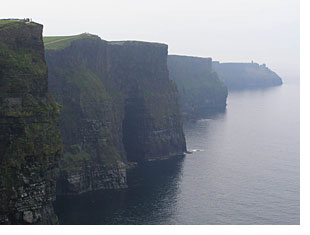 William Butler Yeats famously wrote that “romantic Ireland’s dead and gone” in 1913, and no place conveyed a sense of curiosity about those words more than the Cliffs of Moher—the country’s highest cliffs.
William Butler Yeats famously wrote that “romantic Ireland’s dead and gone” in 1913, and no place conveyed a sense of curiosity about those words more than the Cliffs of Moher—the country’s highest cliffs.
Before the “Celtic Tiger’s” recent tourism boon, Ireland’s fabled western coast was left behind in another era. Nowadays, although lucky cows still graze the world-class Atlantic vistas, one can see this part of Ireland is rapidly changing.
It was our seventh day in the country, driving around in a “hired” car, and we were definitely excited to see the area. Every tourist we met—in places ranging from Dublin to Killarney—had the cliffs on their itinerary, and every local nodded in approval when we mentioned them on ours. It was the height of summer, a gorgeous sunny day, and our enthusiasm for seeking natural beauty was at an eager high.
Yet our spirits subdued as we neared our destination.
The drive up, unremarkable on its own, was made less enticing by the sight of dozens of tour buses crowding the parking lot—which, of course, commanded a fee. The visitor centre was completely Disney-fied: crammed to capacity, with the dings of cash registers in the well-stocked gift shop a constant buzz.
If that weren’t enough, peddlers offered up traditional CDs, Celtic jewelry, Aran sweaters and personalized Ogham etchings along the sidewalk out of the backs of cars and vans.
Not interested in commerce, we hurried by. Holding hands, we fervently climbed up to the coast, only to find giant cranes and bulldozers silhouetting the future: the construction of an expanded visitor centre—complete with a restaurant, observation deck and all sorts of amenities—to ensure even greater future convenience. (Not exactly appealing to a poet’s sensibilities.)
The cliffs were now in sight, but amid the clatter of tourists and construction, it was hard to grasp their beauty. Looking back, I’m quite certain both our faces were pretty candid with disappointment.
 Yet when we climbed to where the guardrails ended—beyond a sign that read “do not go beyond this point” in a fittingly disregarded European way—the unspoiled, peaceful vistas made us suddenly forget the smell of diesel fuel.
Yet when we climbed to where the guardrails ended—beyond a sign that read “do not go beyond this point” in a fittingly disregarded European way—the unspoiled, peaceful vistas made us suddenly forget the smell of diesel fuel.
Here, the tour bus crowds and their tight schedules didn’t seem to venture. Along hundreds of meters of dirt pathway, just on the edge of the coast, no one was selling anything.
Glaringly absent were the drones of vehicles struggling down the narrow Irish highways; the constant shutter of cameras going off; and the multilingual gabbing humdrum of where and when. Here, there were just a few quiet souls, smoking cigarettes, picnicking, reading, journaling…
 …And the views! It was difficult initially to grasp how gorgeous the cliffs really are. The jade and emerald hills sloped down to 200-meter rocky cliffs, contrasting the rugged black and white rocks with lush ivy. Peering over the edge, the awe-inspiring drop into the azure waters was enough to get my blood flowing and my mind alive with wonder.
…And the views! It was difficult initially to grasp how gorgeous the cliffs really are. The jade and emerald hills sloped down to 200-meter rocky cliffs, contrasting the rugged black and white rocks with lush ivy. Peering over the edge, the awe-inspiring drop into the azure waters was enough to get my blood flowing and my mind alive with wonder.
It was here, too, that we really appreciated the birds.
Home to roughly 30,000 of them, the cliffs house one of the largest colonies of Atlantic Puffins in Ireland, as well as nearly 30 other species including guillemots, gulls, shags, razorbills and fulmars.
The birds’ shrieking and singing brought imagery of a crowded room of excited school children—vibrant with life, swirling and swarming around the spectacular backdrop.
Tourism is now the largest industry in Ireland. This once-struggling nation now has the second highest gross domestic product (GDP) per capita within the European Union—second only to Luxembourg. According to statistics generated by the Irish Tourism Board, tourism revenue has more than doubled in the past decade.
Young families are staying, opening bed & breakfasts to cater to the tourist windfall, and most importantly, raising families at home instead of emigrating. This is a far cry from just 45 years ago, when the country’s population reached an all-time low—there were a million less inhabitants in 1961 than there were following the 1840s Irish potato famine.
The Cliffs of Moher, in their raw and stunning glory, serve as the perfect contrast of antiquated and contemporary Ireland. The area is, of course, a must-see if you make it to the Emerald Isles, but surely not intended for tight tour bus schedules or drive-by tourism—the results will certainly disappoint.
Yet that sort of travel pattern is increasingly common in a nation that’s only roughly the size of West Virginia.
“You can’t just get out of the car 20 minutes in a place,” one of the local bed & breakfast owners mused to me on the country’s burgeoning industry. “But some people just want to say they’ve been there.”
A few days contemplation, a boat ride and a couple of good seafood dinners later, my husband and I continued our journey, away from the cliffs and their storied, striking coast. We went up to Doolin and Galway, and then back east to Athlone and Dublin.
We saw many other special spots during our stay, but I remember the cliffs the most vividly of all. There we realized the Irish romanticism that we so eagerly sought might, in fact, still be alive—but only for those who venture to find it.
Perhaps if Yeats were alive today, he might be a bit inspired after all.
About the author:
This week Traveling Tales welcomes Erin Wiggins Shaver who lives in Colorado,USA. She’s a newlywed, freelance writer and full time editor.
Photos by Erin Wiggins Shaver:
1: The Cliffs of Moher, County Clare, Ireland.
2: The sign told people not to pass, but few followed. The results were worth it.
3: The rewarding and lightly trafficked trail went on for miles along the coast.
If You Go:
• The Cliffs of Moher are in County Clare, Ireland. Current visitor centre construction is slated to be completed in early 2007.
• Nearby Doolin is a great homebase for touring the area. The town is tiny, lively, touristy and sleepy all at the same time. Seeing is believing!
http://www.doolinireland.net/
http://www.doolin.biz/
• The cliffs can be reached by foot or by boat. Cruises to the cliffs will cost you about 20 euros per person and run from April 1 to October 31. Daily trips also go to the Aran Islands.
http://www.cliffs-of-moher-cruises.com/
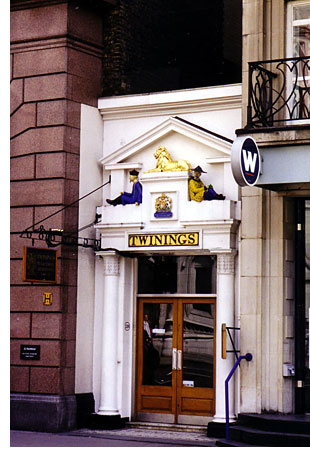
 I walked into a room 400 years old, with oak paneling, wide-planked floors and leaded windows in a bay overlooking the street. Looking upwards, I saw an exquisite Jacobean plaster ceiling, with vines and budding flowers. I was surprised such fragile beauty survived. I had just visited the Imperial War Museum, and the ravages of the blitz were firmly in my mind.
I walked into a room 400 years old, with oak paneling, wide-planked floors and leaded windows in a bay overlooking the street. Looking upwards, I saw an exquisite Jacobean plaster ceiling, with vines and budding flowers. I was surprised such fragile beauty survived. I had just visited the Imperial War Museum, and the ravages of the blitz were firmly in my mind. But the best artifact of all was a line of leather chairs, Pepys’ dining room set, and a long table with his pewter inkwell and a plume. I imagined him sitting at the table, in the beginning of his career perhaps eating nothing but pease soup with his wife, supplemented by dinners at his patrons’ homes.
But the best artifact of all was a line of leather chairs, Pepys’ dining room set, and a long table with his pewter inkwell and a plume. I imagined him sitting at the table, in the beginning of his career perhaps eating nothing but pease soup with his wife, supplemented by dinners at his patrons’ homes.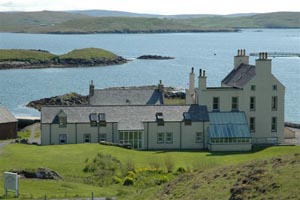 From Burrastow House, my guest home on the West Mainland, I set off on a sheep track that winds its way over the moor and along the ragged coastal cliff-tops. It is sheer beauty, and peaceful, a silence broken only by the stirring of wind, the crash of waves and the cry of the kittiwakes. After dining at my seaside accommodation on lobster caught in the Sound and served up fresh by Belgian Chef Pierre, I wanted the exercise of a short walk along the rugged, rocky shoreline. Each new bay and craggy outcrop draws me onward, however, and the late summer light has me walking well into the night. The trek is as much a part of the senses as it is visual. From this barren land one never ceases to pluck strangely rewarding experiences. It sharpens the senses; eyesight, sounds, and the smells of the moors. Peat bog and mist, the smell of the sea and decay, the sounds of the water flowing down the hillsides, rain, wind, and the distant bleating of sheep. Spring quill covers the rocky knolls, and Thrift grows like lichen on the black rock, colouring it pink. Marsh Marigold grows in the moist soils – yellow flowers following the damp draws. Purplish-black Heath Spotted orchids grow in the boggy areas. Floating in the white peat water are the white heads of water lilies. The grass, short and tough, is of a greyish-green colour, almost a dull blue in certain heights, interspersed with clumps of heather. I had travelled to the Shetlands the night before aboard a Northlink Ferry from Aberdeen. I was out of my berth and up on deck in the early hours. I suppose I wanted to shout “Land Ho!” but the fog was as thick as the proverbial pea soup. So we were almost on top of the landing dock in Lerwick before there was any indication that the Shetland Islands did indeed exist out here in the North Atlantic. Lerwick is Shetland’s capital, a busy port that once provided shelter for Viking fleets, and now harbours glamorous yachts, cruise liners and fishing boats. At the heart of the town is the picturesque Market Cross and Commercial Street, a stone-flagged, winding, narrow lane flanked by tall granite buildings. Here I find the Tourism Centre, and the helpful staff sets me up for my island stay.
From Burrastow House, my guest home on the West Mainland, I set off on a sheep track that winds its way over the moor and along the ragged coastal cliff-tops. It is sheer beauty, and peaceful, a silence broken only by the stirring of wind, the crash of waves and the cry of the kittiwakes. After dining at my seaside accommodation on lobster caught in the Sound and served up fresh by Belgian Chef Pierre, I wanted the exercise of a short walk along the rugged, rocky shoreline. Each new bay and craggy outcrop draws me onward, however, and the late summer light has me walking well into the night. The trek is as much a part of the senses as it is visual. From this barren land one never ceases to pluck strangely rewarding experiences. It sharpens the senses; eyesight, sounds, and the smells of the moors. Peat bog and mist, the smell of the sea and decay, the sounds of the water flowing down the hillsides, rain, wind, and the distant bleating of sheep. Spring quill covers the rocky knolls, and Thrift grows like lichen on the black rock, colouring it pink. Marsh Marigold grows in the moist soils – yellow flowers following the damp draws. Purplish-black Heath Spotted orchids grow in the boggy areas. Floating in the white peat water are the white heads of water lilies. The grass, short and tough, is of a greyish-green colour, almost a dull blue in certain heights, interspersed with clumps of heather. I had travelled to the Shetlands the night before aboard a Northlink Ferry from Aberdeen. I was out of my berth and up on deck in the early hours. I suppose I wanted to shout “Land Ho!” but the fog was as thick as the proverbial pea soup. So we were almost on top of the landing dock in Lerwick before there was any indication that the Shetland Islands did indeed exist out here in the North Atlantic. Lerwick is Shetland’s capital, a busy port that once provided shelter for Viking fleets, and now harbours glamorous yachts, cruise liners and fishing boats. At the heart of the town is the picturesque Market Cross and Commercial Street, a stone-flagged, winding, narrow lane flanked by tall granite buildings. Here I find the Tourism Centre, and the helpful staff sets me up for my island stay.  Six miles to the west of Lerwick is the ancient capital Scalloway, a pretty village with pastel coloured buildings. Scalloway Castle looks down on the harbour, and the Scalloway museum tells of the “Shetland Bus” operation in the Second World War, where the town became a secret base for Norwegian resistance. After breakfast, I drive 40 kilometres south along the coast road, past Shetland ponies, sheep, and old stone croft houses, following a narrow peninsula to the Sumburgh Head Nature Reserve. Here I see Puffins, Gannets, Guillemots and Kittiwakes that roost on the sheer cliffs which rise from the Atlantic in steep-sided splendour. Out to sea I see whales breeching, and in the bays and inlets otters and Grey seals frolic. On my return journey north, I stop to witness Shetland’s long and colourful history and its archeological wonders which date back to Neolithic times, when the first island settlers arrived in fragile wooden boats over 6,000 years ago. The village of Jarlshof near the Sumburgh Hotel, spans 3,000 years of continuous settlement, from Neolithic to Viking times, from the late Bronze Age through to the Middle Ages. It was only recently discovered, when a series of severe storms washed away the protective layer of sand and exposed the site in 1905. Over 6,800 sites of archeological interest can be found peppered all across Shetland; ancient houses, burial chambers, standing stones, brochs and early chapels. The Iron Age broch at Mousa stands impressively 13 metres high above the sea, the only complete broch in the world.
Six miles to the west of Lerwick is the ancient capital Scalloway, a pretty village with pastel coloured buildings. Scalloway Castle looks down on the harbour, and the Scalloway museum tells of the “Shetland Bus” operation in the Second World War, where the town became a secret base for Norwegian resistance. After breakfast, I drive 40 kilometres south along the coast road, past Shetland ponies, sheep, and old stone croft houses, following a narrow peninsula to the Sumburgh Head Nature Reserve. Here I see Puffins, Gannets, Guillemots and Kittiwakes that roost on the sheer cliffs which rise from the Atlantic in steep-sided splendour. Out to sea I see whales breeching, and in the bays and inlets otters and Grey seals frolic. On my return journey north, I stop to witness Shetland’s long and colourful history and its archeological wonders which date back to Neolithic times, when the first island settlers arrived in fragile wooden boats over 6,000 years ago. The village of Jarlshof near the Sumburgh Hotel, spans 3,000 years of continuous settlement, from Neolithic to Viking times, from the late Bronze Age through to the Middle Ages. It was only recently discovered, when a series of severe storms washed away the protective layer of sand and exposed the site in 1905. Over 6,800 sites of archeological interest can be found peppered all across Shetland; ancient houses, burial chambers, standing stones, brochs and early chapels. The Iron Age broch at Mousa stands impressively 13 metres high above the sea, the only complete broch in the world. 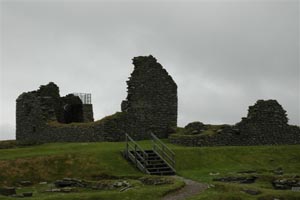 The 6th Century saw monks arrive from Ireland and West Scotland to spread new religion. The Norsemen arrived in 800 AD, the geographical location of the Islands was great as a stepping stone for North Atlantic voyages. In 1469, Christian 1 of Denmark, Norway and Sweden pledged Orkney and Shetland as a dowry for his daughter on her marriage to James III, and the Shetlands became part of Scotland. Just don’t tell them that.
The 6th Century saw monks arrive from Ireland and West Scotland to spread new religion. The Norsemen arrived in 800 AD, the geographical location of the Islands was great as a stepping stone for North Atlantic voyages. In 1469, Christian 1 of Denmark, Norway and Sweden pledged Orkney and Shetland as a dowry for his daughter on her marriage to James III, and the Shetlands became part of Scotland. Just don’t tell them that.